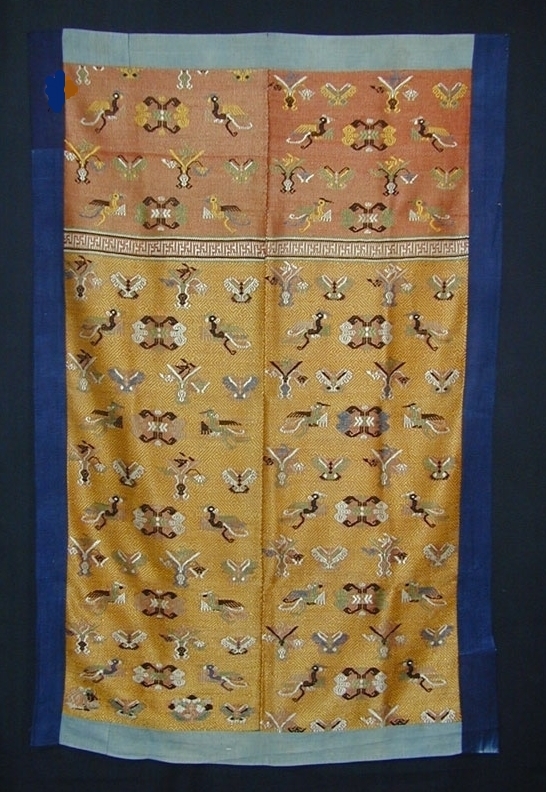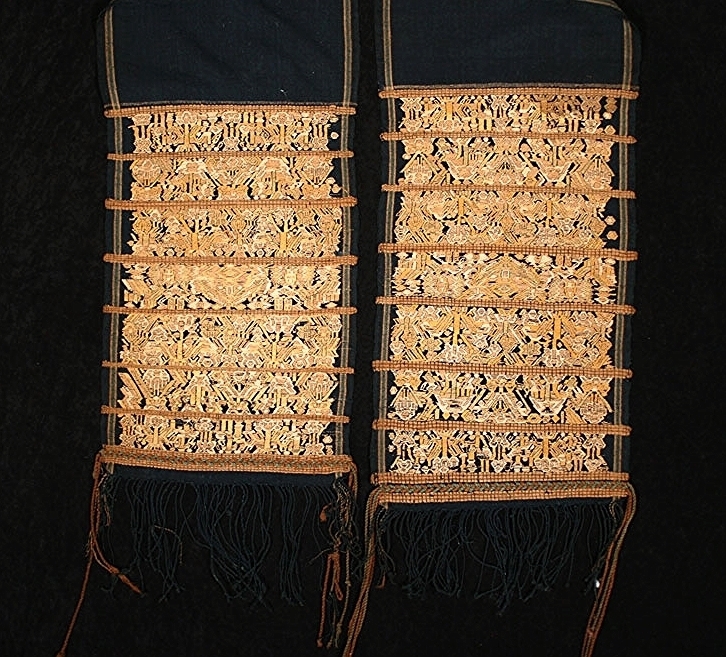
A length of plaid cotton cloth with cross-stitch silk embroidery displays a wide colorful band with confronting birds at each end. The cloth was wrapped around the head many times to form a layered turban. Most antique artifacts from the Huayao are quite rare as the population is small and their textile tradition has diminished over time.

A rare and lustrous tapestry woven blanket bordered in plain-woven cotton.

The overall presentation and unusual background color make it appear as if the florets are floating in space.

Antique jackets with silk embroidery on cotton in very good condition like this one from the Miao people of Danzai are very rare.

Similar embroidered head cloths may be from northern Thailand or Laos.

Replete with auspicious figures and symbols in silk embroidery on cotton, robes like this one empowered the highest level Yao priest or shaman to perform ceremonies and intervene with ancestral ghosts.

An important procession takes place in an exceptionally wide band around the mid-point of this excellent example of a Ha Li ceremonial tube skirt.

In the latter part of the 20th century only one or two families could still produce clothing like this made of joined pieces of fish skin, which makes even the later pieces extremely rare.

Row upon row of ancestor or processional figures in discontinuous silk supplementary weft make this an outstanding example of a Ha Li tube skirt.

Subtle and abstract ancestor figures adorn this excellent example of a Ha sub-tribe Li woman's skirt with a brocade weave.

One of the most rare and graphic of the Meifu Li women's head cloths through silk embroidery on cotton at each end of a long narrow cloth wrap.


A very full and rare Li woman's head cloth of silk embroidery on cotton depicting spiritual and everyday life.

Silk square patterns in cross-stitch embroidery on cotton identify this unusual top as belonging to Miao from Guangxi Province.

Yao woman’ headdress of stiffened cotton covered with a folded embroidered head cloth and adorned by three bright red pom-poms. A separate etched bone comb with glass beads was worn at back and added a fourth pom-pom to this very distinctive hat.

A vibrant Buyi wedding blanket of silk supplementary weave on cotton.

A superb example of a Dandu Miao festive quilted woman's jacket which incorporates several sewing and dyeing techniques: embroidery, calendaring with egg white and colorful batik.

This is a highly unusual example that follows the typical construction of wedding blankets but is replete with cranes and phoenixes, feminine symbols. It was probably a presentation blanket for a matriarch, perhaps on her 60th birthday. The significance of the Maonan blankets in the life cycle is exemplified here even though its purpose may be atypical.

Not every Yao embroidered head cloth displays rows of pompoms like this one which was worn as the top layer of several similar plain or embroidered cloths that covered a Yao (Mien) woman's structured headdress.

Malipo Yi man’s tunic with silk appliqué on cotton and in trim on the sleeves (a beautiful and unusual addition); and cotton batik sleeves and hem. This tunic appears to be in rare original and excellent condition.

This labor-intensive Hmong woman's skirt features fine indigo batik along the bottom and hundreds of small pleats.

Indigo dyed stenciled batik on three joined panels with fine detail in the figures of dragons, chili and phoenixes.

Meifu Li women's skirts with symbols and figures depicted in ikat fall into two categories: those with a band of silk supplementary weft and those that without that alternate ikat with plain weave. Those with the supplementary weave speak to a higher level of the weaver's skill.

Many Ha Li textiles feature ancestral or processional figures indicating they most likely were used for festivals and ceremonies. The presentation varies with sub-tribe or village.

A very rare and lustrous Maonan wedding blanket of silk supplementary weave on cotton.

For the highest level Yao priest, a hat of woven human hair conferred spiritual authority. According to the testimony of a priest in northern Thailand in the 1990s, even a small patch of human hair from a worn out old hat could serve to sanctify rituals. A complete hat is rare and highly important.

Long bei (dragon cover) in three separate woven cotton panels. The rich, dense and vibrant silk embroidery includes an elaborate floral theme with flowers, vases and birds surrounding a central rectangle with mang dragons, qilin and phoenixes.

A wonderful example of a Yi wedding tunic made striking through the use of bold and graphic appliqué.

Stenciled batik creates a night and day presentation with positive and negative graphics juxtaposing geometric and humanoid forms.

One of many fascinating varieties of headdresses used by Yao sub-tribes during festivals and ceremonies, this hat with two peaks of stiffened cotton and strings of glass beads supports streamers, tassels and layers of plain and embroidered head cloths.

One of the most beautiful examples of Yao appliqué with a lovely balance of color, design and protective devices.

Run sub-tribe skirts often incorporate genealogy, architecture and everyday life into their woven patterns.

A rare complete and all original Hua Yao woman's skirt. The main section is embroidered with cotton mostly in cross stitches and is bordered by two gathered cotton panels woven in silk supplementary weft.

Although this exquisite textile is from one of the largest Chinese minority, the quality of its work places it among a small rare group of superb weavers.

Quilted woman's jacket enhanced with touches of silk embroidery.

An outstanding example of a Meifu Li woman's skirt with ikat and silk supplementary weave.

We have seen only a few of these Taoist hand-painted robes from Hunan, mostly on linen. The cotton base on this one gives a certain brightness and clarity to the painted figures.





































A length of plaid cotton cloth with cross-stitch silk embroidery displays a wide colorful band with confronting birds at each end. The cloth was wrapped around the head many times to form a layered turban. Most antique artifacts from the Huayao are quite rare as the population is small and their textile tradition has diminished over time.
A rare and lustrous tapestry woven blanket bordered in plain-woven cotton.
The overall presentation and unusual background color make it appear as if the florets are floating in space.
Antique jackets with silk embroidery on cotton in very good condition like this one from the Miao people of Danzai are very rare.
Similar embroidered head cloths may be from northern Thailand or Laos.
Replete with auspicious figures and symbols in silk embroidery on cotton, robes like this one empowered the highest level Yao priest or shaman to perform ceremonies and intervene with ancestral ghosts.
An important procession takes place in an exceptionally wide band around the mid-point of this excellent example of a Ha Li ceremonial tube skirt.
In the latter part of the 20th century only one or two families could still produce clothing like this made of joined pieces of fish skin, which makes even the later pieces extremely rare.
Row upon row of ancestor or processional figures in discontinuous silk supplementary weft make this an outstanding example of a Ha Li tube skirt.
Subtle and abstract ancestor figures adorn this excellent example of a Ha sub-tribe Li woman's skirt with a brocade weave.
One of the most rare and graphic of the Meifu Li women's head cloths through silk embroidery on cotton at each end of a long narrow cloth wrap.
A very full and rare Li woman's head cloth of silk embroidery on cotton depicting spiritual and everyday life.
Silk square patterns in cross-stitch embroidery on cotton identify this unusual top as belonging to Miao from Guangxi Province.
Yao woman’ headdress of stiffened cotton covered with a folded embroidered head cloth and adorned by three bright red pom-poms. A separate etched bone comb with glass beads was worn at back and added a fourth pom-pom to this very distinctive hat.
A vibrant Buyi wedding blanket of silk supplementary weave on cotton.
A superb example of a Dandu Miao festive quilted woman's jacket which incorporates several sewing and dyeing techniques: embroidery, calendaring with egg white and colorful batik.
This is a highly unusual example that follows the typical construction of wedding blankets but is replete with cranes and phoenixes, feminine symbols. It was probably a presentation blanket for a matriarch, perhaps on her 60th birthday. The significance of the Maonan blankets in the life cycle is exemplified here even though its purpose may be atypical.
Not every Yao embroidered head cloth displays rows of pompoms like this one which was worn as the top layer of several similar plain or embroidered cloths that covered a Yao (Mien) woman's structured headdress.
Malipo Yi man’s tunic with silk appliqué on cotton and in trim on the sleeves (a beautiful and unusual addition); and cotton batik sleeves and hem. This tunic appears to be in rare original and excellent condition.
This labor-intensive Hmong woman's skirt features fine indigo batik along the bottom and hundreds of small pleats.
Indigo dyed stenciled batik on three joined panels with fine detail in the figures of dragons, chili and phoenixes.
Meifu Li women's skirts with symbols and figures depicted in ikat fall into two categories: those with a band of silk supplementary weft and those that without that alternate ikat with plain weave. Those with the supplementary weave speak to a higher level of the weaver's skill.
Many Ha Li textiles feature ancestral or processional figures indicating they most likely were used for festivals and ceremonies. The presentation varies with sub-tribe or village.
A very rare and lustrous Maonan wedding blanket of silk supplementary weave on cotton.
For the highest level Yao priest, a hat of woven human hair conferred spiritual authority. According to the testimony of a priest in northern Thailand in the 1990s, even a small patch of human hair from a worn out old hat could serve to sanctify rituals. A complete hat is rare and highly important.
Long bei (dragon cover) in three separate woven cotton panels. The rich, dense and vibrant silk embroidery includes an elaborate floral theme with flowers, vases and birds surrounding a central rectangle with mang dragons, qilin and phoenixes.
A wonderful example of a Yi wedding tunic made striking through the use of bold and graphic appliqué.
Stenciled batik creates a night and day presentation with positive and negative graphics juxtaposing geometric and humanoid forms.
One of many fascinating varieties of headdresses used by Yao sub-tribes during festivals and ceremonies, this hat with two peaks of stiffened cotton and strings of glass beads supports streamers, tassels and layers of plain and embroidered head cloths.
One of the most beautiful examples of Yao appliqué with a lovely balance of color, design and protective devices.
Run sub-tribe skirts often incorporate genealogy, architecture and everyday life into their woven patterns.
A rare complete and all original Hua Yao woman's skirt. The main section is embroidered with cotton mostly in cross stitches and is bordered by two gathered cotton panels woven in silk supplementary weft.
Although this exquisite textile is from one of the largest Chinese minority, the quality of its work places it among a small rare group of superb weavers.
Quilted woman's jacket enhanced with touches of silk embroidery.
An outstanding example of a Meifu Li woman's skirt with ikat and silk supplementary weave.
We have seen only a few of these Taoist hand-painted robes from Hunan, mostly on linen. The cotton base on this one gives a certain brightness and clarity to the painted figures.